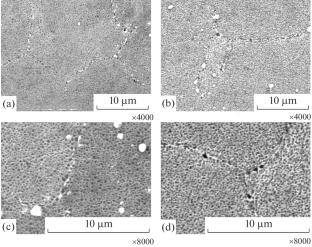热处理对颗粒状合金EP741NP不同截面试样微观组织形成的影响
IF 0.3
Q4 MATERIALS SCIENCE, MULTIDISCIPLINARY
引用次数: 0
摘要
研究了连续时效对颗粒状耐热镍合金EP741NP试样组织和性能的影响。使用连续时效可以增加γ′相颗粒的析出密度,减小其尺寸和晶粒内的混凝程度,并加强与碳化物和硼化物化合物的边界。微观组织的稳定使其有可能提高抗拉强度和屈服强度水平。本文章由计算机程序翻译,如有差异,请以英文原文为准。

Influence of Heat Treatment on Formation of Microstructure in Samples of Different Cross Sections Obtained from Granulated Alloy EP741NP
The effect of continuous aging on the microstructure and properties of samples made of granulated heat-resistant nickel alloy EP741NP is considered. The use of continuous aging made it possible to increase the density of the precipitation of γ' phase particles, reducing their size and the degree of coagulation inside the grains, and to strengthen the boundaries with carbide and boride compounds. Stabilization of the microstructure made it possible to increase the level of tensile strength and yield strength.
求助全文
通过发布文献求助,成功后即可免费获取论文全文。
去求助
来源期刊

Inorganic Materials: Applied Research
Engineering-Engineering (all)
CiteScore
0.90
自引率
0.00%
发文量
199
期刊介绍:
Inorganic Materials: Applied Research contains translations of research articles devoted to applied aspects of inorganic materials. Best articles are selected from four Russian periodicals: Materialovedenie, Perspektivnye Materialy, Fizika i Khimiya Obrabotki Materialov, and Voprosy Materialovedeniya and translated into English. The journal reports recent achievements in materials science: physical and chemical bases of materials science; effects of synergism in composite materials; computer simulations; creation of new materials (including carbon-based materials and ceramics, semiconductors, superconductors, composite materials, polymers, materials for nuclear engineering, materials for aircraft and space engineering, materials for quantum electronics, materials for electronics and optoelectronics, materials for nuclear and thermonuclear power engineering, radiation-hardened materials, materials for use in medicine, etc.); analytical techniques; structure–property relationships; nanostructures and nanotechnologies; advanced technologies; use of hydrogen in structural materials; and economic and environmental issues. The journal also considers engineering issues of materials processing with plasma, high-gradient crystallization, laser technology, and ultrasonic technology. Currently the journal does not accept direct submissions, but submissions to one of the source journals is possible.
 求助内容:
求助内容: 应助结果提醒方式:
应助结果提醒方式:


